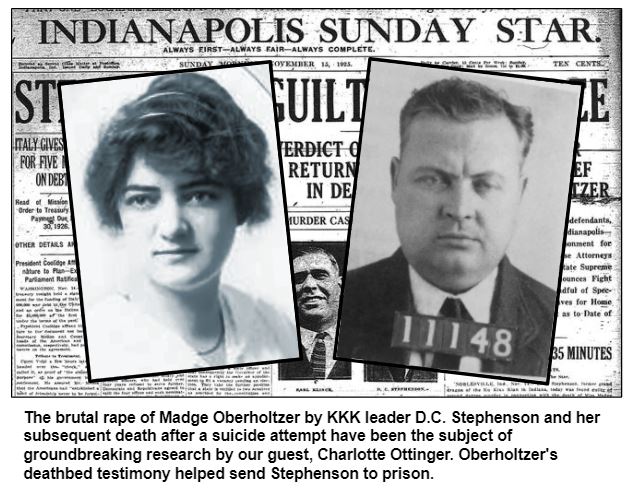Saturdays, noon to 1 p.m. ET on WICR 88.7 FM.
Or stream audio live from anywhere on WICR Online!
March 13, 2021
Madge Oberholtzer: more than victim of a shocking crime in 1925
She was the victim of one of the most lurid crimes in Indiana history, the brutal rape in March 1925 by D.C. Stephenson, Grand Dragon of the Ku Klux Klan, that led to her eventual death after a suicide attempt. The deathbed testimony of Madge Oberholtzer, a resident of the Irvington neighborhood of Indianapolis, resulted in the eventual conviction of Stephenson of second degree murder, a pivotal episode in the downfall of the Klan in Indiana during the 1920s.
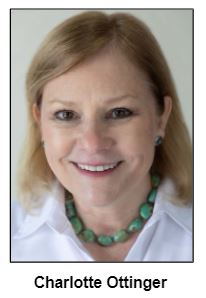
Charlotte, who is convinced Madge did not willingly go on the train trip, will be Nelson's guest to discuss her extensive research. She has interviewed four grandchildren of Madge's brother, who have given her family documents, photos and other artifacts never seen by the general public or used by other researchers. Some of the material is now in the archives of the Irvington Historical Society; Charlotte is a former board member.
There's even a Women's History Month aspect for our show. According to Charlotte's research into Madge's youth, she was mentored by several Indiana suffragists. Madge graduated from Manual High School in 1914 and attended Butler University, which then was Butler College and located in Irvington. According to Charlotte, the talent in painting and drawing that Madge displayed at Manual earned her scholarships to study at the Herron School of Art.
During our show, Charlotte will describe the impact of Madge's tragic death on her family. Madge's mother, Matilda Oberholtzer, was a short-term patient in a sanitarium in Martinsville after her daughter's death.
An American Sign Language medical interpreter as well as a nurse, Charlotte says her medical background helped her sort through the treatment provided to Madge, the autopsy results and the extensive medical testimony at Stephenson's sensational trial. After her brutal rape in Stephenson's private train car, Madge swallowed poison in a hotel room in Hammond.
Hoosier History Live has discussed the frightening power of Stephenson - who once declared "I am the law in Indiana" - during previous shows. They have included a show last September in which Nelson interviewed James Madison, author of The Ku Klux Klan in the Heartland (IU Press).
Charlotte's book, tentatively titled The Life and Times of Madge Oberholtzer, is scheduled for publication in October.

According to Charlotte, other women had been physically and sexually assaulted by Stephenson (1891-1966). "None of them came forward to expose him," Charlotte notes. "Madge was the only woman who publicly exposed him."
A native of Texas, Stephenson already had abandoned a wife and daughter in Oklahoma before arriving in Indiana in 1920, according to Grand Dragon: D.C. Stephenson and the Ku Klux Klan in Indiana (Purdue University Press, 1991) by William Lutholtz. Stephenson, Lutholtz wrote, was a chronic liar who "told so many lies so often that it's difficult to know the truth" about his early life.
Following Madge's death in 1925 in her family's home - where Stephenson had her returned after the train trip - his trial for second-degree murder was held at the Hamilton County Courthouse in Noblesville. Charlotte Ottinger notes that Madge's father died two years later, "some say of a broken heart."
Roadtrip: Julian-Clarke House in Irvington
Guest Roadtripper Suzanne Stanis, director of heritage education at Indiana Landmarks, tells us that although Irvington was home to the notorious KKK leader D.C. Stephenson, the National Register Historic District is more aptly associated with the artists, scholars, authors, philanthropists and social reformers who have occupied the neighborhood over the years.
And to celebrate the many positive contributions made by residents of Irvington, Suzanne suggests a Roadtrip to the Julian-Clarke House. Although the home is privately owned and not open for tours, it can be viewed from the street, along with the multitude of other lovely historic homes in Irvington.
Grace Julian Clarke, a suffragist and social reformer, moved to Irvington as a child and called the residence at 115 South Audubon home until her death in 1938. Grace's father, George Julian, had constructed the house in 1873, when Grace was eight. As a United States Congressman, George Julian introduced the first federal suffrage amendment to the constitution in 1868 and proposed an eight-hour workday. Newspaper articles recount visits to the house by prominent suffragists Susan B. Anthony and Mary Livermore.
Grace continued the reform tradition by founding the Women's Franchise League of Indiana (predecessor to the League of Women Voters), helping to form a Women's School Commission that helped elect the first woman to the Indianapolis School Board, and serving as head of the Women's Division of the Federal Employment Bureau.
And to get a feel of what the interior of the house looked like when Grace Julian Clarke lived there, Suzanne refers us to a detailed description written by reporter Agnes McCulloch Hanna in 1929 for the Indianapolis Star. The article is available in the Indiana Landmarks Wilbur D. Peat Collection at IUPUI's University Library. Indiana Landmarks purchased the house in 1985 and resold it with protective covenants.
We get by with a little help from our friends
Everyone could use a little help now and then, and Hoosier History Live is no exception.
If you are part of an organization or business that would like a promotional boost, please consider providing a prize for the weekly History Mystery feature of our show. The name of your organization or business will be posted on our online media, and you also get a mention during the live show by our host Nelson. Prizes must fit in a standard business envelope, such as tickets, passes or vouchers. Contact our producer Molly Head, molly@hoosierhistorylive.org, for more information.
We always strive to feature exciting new guests and intriguing topics on the show, but we'd love to get some fresh ideas from our listeners. If you have a suggestion for a featured guest or a main topic for a show, please reach out to Molly at the same email address posted above. Include "guest/show topic idea" in the email header. If you do propose a topic, you must include possible guests who could speak authoritatively about it, and their contact information. Include some notes to support your idea, too. Be aware that we do make our own editorial decisions.
As the danger of the pandemic passes and social distancing restrictions ease, we're also hoping to revive Hoosier History Live listening groups, and we are reaching out to volunteer organizers. The idea behind the listening groups is for people to gather on Saturdays a little before noon, listen to the live show and then discuss. It's a great social and educational opportunity for libraries, small businesses, and history and community centers. All you need is an organizer, a listening device such as a radio or a computer or phone hooked up to a speaker, and a quiet place with comfortable chairs. Again, contact Molly Head if you'd like help setting up a listening group.
And finally, we always appreciate your financial support. Our researchers, writers, editors, artists, and marketers are working hard to keep Hoosier History Live part of the intellectual life of our beloved Indiana, and we can't do it without you. You can visit the yellow Donate button on our website or newsletter to use a bank account or PayPal, or write a check to Hoosier History Live and send it to P.O. Box 44393, Indianapolis IN 46244-0393.
Thanks, friends, for helping to support local journalism!
Nelson Price, host and historian
Molly Head, producer/general manager, (317) 927-9101
Mick Armbruster, associate producer
Cheryl Lamb, administrative manager
Richard Sullivan, senior tech consultant
Pam Fraizer, graphic designer
Garry Chilluffo, consultant
Please tell our sponsors that you appreciate their support!

 For organizational sponsorship, which includes logos, links, and voiced credits in the show and in podcasts, email molly@hoosierhistorylive.org, or call (317) 927-9101 for information. Our podcast listens are increasing and we are being distributed on Indiana Memory and the National Digital Public Library. Grow with us as our podcast and internet presence expands! Thanks also to Visit Indy, Fraizer Designs, WICR-FM, Henri Pensis, Genesis Brown, Kielynn Tally, Heather McIntyre, Justin Clark, and many other individuals and organizations.
For organizational sponsorship, which includes logos, links, and voiced credits in the show and in podcasts, email molly@hoosierhistorylive.org, or call (317) 927-9101 for information. Our podcast listens are increasing and we are being distributed on Indiana Memory and the National Digital Public Library. Grow with us as our podcast and internet presence expands! Thanks also to Visit Indy, Fraizer Designs, WICR-FM, Henri Pensis, Genesis Brown, Kielynn Tally, Heather McIntyre, Justin Clark, and many other individuals and organizations.
Thank you!
We'd like to thank the following recent, new and renewal contributors whose donations help make this show possible!
- Kathleen Angelone
- Tim and Meg Shelly
- Connor & Company, Inc.
- Georgia Cravey and Jim Lingenfelter
- Ann Frick
- Yetta Wolen
- In memory of William G. "Bill" Mihay
- Dr. William McNiece
- Michael Freeland and Sharon Butsch Freeland
- David E. and Lynne J. Steele
- Stacia Gorge
- Margaret Smith
- Rachel Perry
- Tom and Linda Castaldi
- Greg Larson
- Marion Wolen
March 20, 2021 - coming up
Weir Cook and Paul Baer, WWI aviators and former airport namesakes: encore
Both were pioneer aviators and heroic World War I fighter pilots from Indiana, and both were killed while flying aircraft overseas.
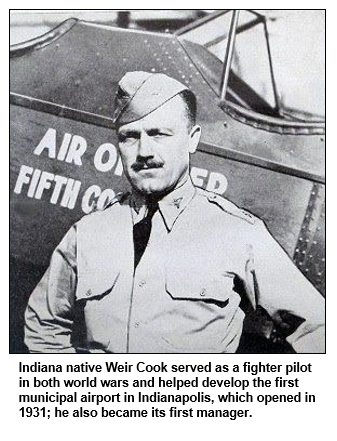
To explore the lives of the aviators who earned national acclaim for their valor during what once was known as the Great War, Nelson is joined by two guests in this encore of a show originally broadcast in 2018. The guests are:
- William Bell, an Indianapolis-based writer and retired law enforcement officer who has researched Hancock County native Weir Cook (1892-1943), recipient of the Distinguished Service Cross in World War I. Cook also was hailed as a hero during World War II even though he was well into his 40s when he returned to the Army Air Corp and flew combat missions over the Pacific.
- And Tony Garel-Frantzen of Fort Myers, Fla., the author of Hoosier Aviator Paul Baer: America's First Combat Ace (The History Press, 2017). In his biography of Baer (1894-1930), Tony contends the Fort Wayne native became the first American to shoot down an enemy plane in combat and the first to earn the title of "combat ace." Tony writes that Baer's historic achievements often have been overlooked because he flew for a French squadron prior to the United States' entry into World War I.
The designation of "combat ace," which both Cook and Baer achieved, is given to pilots who accomplish five aerial victories during warfare.
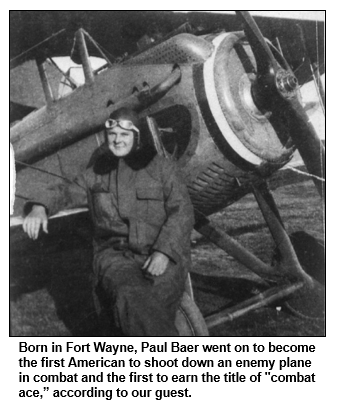
After Cook was killed while flying a combat mission, the Indianapolis airport at Indianapolis was named Weir Cook Airport. In 1976, its name was changed to Indianapolis International Airport, outraging many veterans groups.
When the city's newly constructed airport opened at its current site in 2008, the mid-field terminal and the roadway leading to it were named in Cook's honor.
In Fort Wayne, Baer had grown up as a shy but adventure-seeking youth, according to Hoosier Aviator. After France declared war on Germany in 1914, Baer was among a few American volunteers who signed up to fight on the side of the French; America did not declare war until 1917. As a combat pilot, Baer flew missions for both France and the United States.
While working as a commercial pilot for a Chinese airline in 1930, Baer was killed in an aircraft accident near Shanghai. In his honor, the Fort Wayne airport was called Baer Field until the early 1990s, when it was renamed Fort Wayne International Airport.
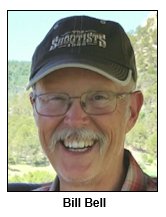
During the war, Cook downed at least seven enemy aircraft and was promoted to flight commander of the 94th Aero Squadron, a pursuit (fighter) unit of the U.S. Army Air Service. After the war, Cook undertook many roles in the civilian aviation industry and helped bring the first municipal airport to Indianapolis. He was killed during World War II in a crash while flying a P-39 Bell Airacobra fighter plane over the Pacific island of New Caledonia.
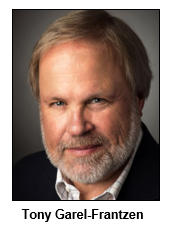
In May 1918, Baer's plane was shot down. Although he escaped serious injuries, Baer became a prisoner of war and spent time in several German prisons.
"True to his reticent nature," Tony writes, "Baer rarely spoke in detail while he was alive about the day he was shot down or about the months he spent in captivity."
Copyright 2021
|

